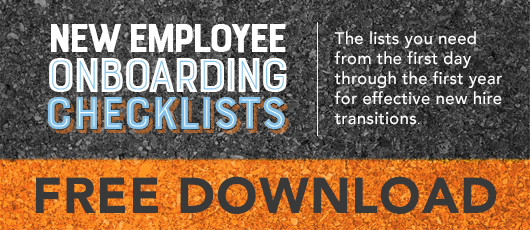[New Hire Checklist] 19 Ways to Make a Great First (and Lasting) Impression

Onboarding should begin well before new employees enter the door for their first day, and should end only when they feel confident in their role and place in the organization.
Think of a new hire as a young college student going on a first date. They might be a little nervous, maybe a little scared, and perhaps even outright second guessing their decision to leave their previous relationship.
Yet it is an employer’s duty to set the stage for a successful relationship. To paraphrase Hitch (great movie!), have organizations do 90% of the work to make a great first impression, leaving the new employee to worry about a small 10% of the effort.
So, how exactly do we make that first great impression? Here are 19 ideas to add to your new hire checklist.
FIRST WEEK
1. Send a Letter
Send a fun letter letting them know how excited you are to work with them! In that letter, provide them with some bios of their new teammates, include a snapshot of their upcoming desk space (even if it’s not ready yet), and throw in a $10 gift card so they can grab a caffeine boost on their way into their first day of work.
2. Start on a Friday
First off, no good things happen on Monday, so why make their experience terrible from the start? By starting on a Friday, you can almost ensure they will leave that day invigorated for the experience ahead.
3. Start Late
Why not give your new hires a 10:00am start time? That’ll give them a few extra hours to get organized for their routine and it’ll give HR, managers, and team members time to prepare in the morning. Leaving a new hire sitting in the lobby at 7:55am while your team rushes to get their desk ready does not make for a great first impression.
4. Build Connections
On a new hires first day, take them out to a team lunch and have them shadow employees all day. Please don’t have them logging into a computer or setting up user access to various accounts or machines all day – make day one all about meaningful connections.
5. Embrace the Suck
Be upfront that their first Monday will be nothing like the prior Friday. That first Monday should consist of the typical HR, compliance, and account access stuff. Filling out forms, booting up computers, and learning about the rules and regulations of the company needs to happen – just not right away.
6. Get to Work
Paper work, office tours, and meeting team members is essential – but when that’s done, it’s time to get to work (I mean, you are paying them? Right?). Assign them relatively low-pressure tasks, giving them exposure to your organization’s expectations.
7. Create an Outline
Provide them with an outline of what a first successful year would look like: What tasks should they have accomplished? What should they be an expert in? If employees can understand the answers to those questions, then the organization is on the way to setting them up for success.
8. Ask for Feedback on Onboarding
Give new hires the chance to provide feedback after their first full week at your company. Did the company and employees make you feel welcome? What did you like about your first week of onboarding? What could we improve?
FIRST MONTH
9. Meet Weekly
Set up weekly touch points between new employees and their immediate manager. Their manager needs to help them develop and prosper in the role, and the best way to do that is to keep a constant pulse on employees’ progress.
10. Role Play
Role-play as much as possible – especially if the role is customer-facing. Nobody wants to be thrown right into the fire. Make sure to hit all aspects of customer interaction – phone calls, webinars, face-to-face interactions, email exchanges, etc. Allow employees to practice in low-pressure situations and give them immediate feedback for ways to improve.
11. Schedule Team Lunches
Set up both inter- and intra-team meetings and lunches for them. Don’t just expect them to go out of their way and meet new people! Each week they should be sitting down with a team member or another department to get an idea of the type of work each group is involved in. Not only does this allow them to get a global perspective of the organization, but they also have a chance to connect with employees.
12. Ask for Feedback on Role
Ask new hires for feedback after the first month. Do you have a clear understanding of their role? Will this role utilize your strengths? Is this job in alignment with your career goals?
FIRST THREE MONTHS
13. Foster Meaningful Interactions
Make sure they are having meaningful interactions with both internal and external customers. Training is likely still happening, but now new hires should feel confident enough to get out there and start making an impact.
14. Provide Performance Feedback
Provide feedback on their performance up to this point. Give them recognition for what has gone well and provide constructive critiques on what could be improved.
15. Ask for Feedback on Experience
Ask them for some more feedback at the three month mark. How has training gone so far? Do you have the necessary resources and technology to excel in the job? Are you making meaningful relationships with their coworkers?
FIRST SIX MONTHS
16. Set the Tone for Your Feedback Culture
Ensure new hires feel comfortable providing and receiving feedback. Some people may not feel comfortable questioning certain processes right away, but eventually we need our people to speak up, ask questions, and provide feedback on how to improve processes. Organizations need all employees to challenge the conventional ways of doing things, and allowing new hires to do that early on gives them a voice in the organization.
17. Revisit Role, Fit, and Expectations
Now that your new hires have gained their bearings, revisit their roles, fit, and expectations. Are employees performing as expected? Do they still seem excited about the role? Rather than waiting for them to speak up, make sure you are constantly keeping tabs on what they like or dislike about the role.
18. Discuss Long-Term Goals
Have a conversation about long-term aspirations. All employees need to think about their career progression, and new hires can start doing this right away. If a goal seems especially lofty, work with them to write out a specific plan to help them achieve their goals.
19. Ask for More Feedback
The six-month mark is another great time to collect new hire feedback to make sure they’re on the right track and that the company is meeting their expectations. Are you connecting with teammates? Are you connecting with your role? Has your experience been what you had hoped for?
Onboarding strategies will vary from company to company, department to department, and manager to manager. Some teams may need to speed up the onboarding process to get employees contributing as soon as possible, while others may have the luxury of extending the process before throwing an employee into live situations.
Regardless of what you can or can’t afford to do with onboarding, one strategy should be at every check point on your new hire checklist: ask for feedback. Throughout all phases of an employee life-cycle, an organization should be collecting employee feedback and monitoring their levels of engagement. Losing an employee because their opinion went unheard can be avoided.
What more could you do to ensure a smooth transition for your new hire? Download the resource below for more new hire checklists, chock-full of everything you need to check off through your new employee's first year!


![[New Hire Checklist] 19 Ways to Make a Great First (and Lasting) Impression](https://www.quantumworkplace.com/hubfs/Website/Blog/Images/Young-woman-at-a-job-interview.-517803454_2125x1416.jpeg)




